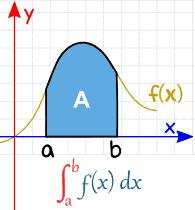Find k if \(\int_{0}^{\frac{1}{2}}[\frac{x^2dx}{(1-x^2)^{\frac{3}{2}}}]=\frac{k}{6}\).
Solution and Explanation
Let's solve the definite integral step by step.
1. Set up the Integral:
We are given the integral:
\[ \int_0^{\frac{1}{2}} \frac{x^2}{(1 - x^2)^{3/2}} \, dx = \frac{k}{6} \]
2. Use Trigonometric Substitution:
Let \( x = \sin(\theta) \), so that \( dx = \cos(\theta) \, d\theta \).
When \( x = 0 \), \( \sin(\theta) = 0 \), so \( \theta = 0 \).
When \( x = \frac{1}{2} \), \( \sin(\theta) = \frac{1}{2} \), so \( \theta = \frac{\pi}{6} \).
Substituting into the integral, we get:
\[
\int_0^{\frac{\pi}{6}} \frac{\sin^2(\theta)}{(1 - \sin^2(\theta))^{3/2}} \cos(\theta) \, d\theta
\]
3. Simplify the Integral:
Using the identity \( 1 - \sin^2(\theta) = \cos^2(\theta) \), we get:
\[
\int_0^{\frac{\pi}{6}} \frac{\sin^2(\theta)}{\cos^3(\theta)} \cos(\theta) \, d\theta
\]
Simplifying further:
\[
\int_0^{\frac{\pi}{6}} \frac{\sin^2(\theta)}{\cos^2(\theta)} \, d\theta
\]
This simplifies to:
\[
\int_0^{\frac{\pi}{6}} \tan^2(\theta) \, d\theta
\]
4. Use Trigonometric Identity:
We know that:
\[
\tan^2(\theta) = \sec^2(\theta) - 1
\]
Therefore, the integral becomes:
\[
\int_0^{\frac{\pi}{6}} (\sec^2(\theta) - 1) \, d\theta
\]
5. Integrate:
The integral of \( \sec^2(\theta) \) is \( \tan(\theta) \), and the integral of 1 is \( \theta \). So, we have:
\[
[\tan(\theta) - \theta]_0^{\frac{\pi}{6}}
\]
6. Evaluate the Limits:
Evaluating at the limits:
\[
\left( \tan\left(\frac{\pi}{6}\right) - \frac{\pi}{6} \right) - \left( \tan(0) - 0 \right)
\]
We know that:
\[
\tan\left(\frac{\pi}{6}\right) = \frac{1}{\sqrt{3}}, \quad \tan(0) = 0
\]
Substituting these values:
\[
\left( \frac{1}{\sqrt{3}} - \frac{\pi}{6} \right) - (0 - 0)
\]
Simplifying:
\[
\frac{1}{\sqrt{3}} - \frac{\pi}{6}
\]
7. Relate to \( k/6 \):
We are given that the integral equals \( \frac{k}{6} \). Thus:
\[
\frac{1}{\sqrt{3}} - \frac{\pi}{6} = \frac{k}{6}
\]
Multiply both sides by 6:
\[
6 \times \left( \frac{1}{\sqrt{3}} - \frac{\pi}{6} \right) = k
\]
Simplifying:
\[
6 \times \frac{1}{\sqrt{3}} - \pi = k
\]
\[
2\sqrt{3} - \pi = k
\]
Therefore, the value of \( k \) is:
\[
k = 2\sqrt{3} - \pi
\]
Top Questions on Definite Integral
- Evaluate the definite integral: \( \int_{-2}^{2} |x^2 - x - 2| \, dx \)
- MHT CET - 2025
- Mathematics
- Definite Integral
- The value of the integral \[ \int_{-1}^{2} \log_e \left( x + \sqrt{x^2 + 1} \right) \, dx \] is:
- JEE Main - 2024
- Mathematics
- Definite Integral
The value \( 9 \int_{0}^{9} \left\lfloor \frac{10x}{x+1} \right\rfloor \, dx \), where \( \left\lfloor t \right\rfloor \) denotes the greatest integer less than or equal to \( t \), is ________.
- JEE Main - 2024
- Mathematics
- Definite Integral
- The value of \(\lim_{{n \to \infty}} \sum_{{k=1}}^{n} \frac{n^3}{{(n^2 + k^2)(n^2 + 3k^2)}}\) is
- JEE Main - 2024
- Mathematics
- Definite Integral
If the value of the integral
\[ \int_{-\frac{\pi}{2}}^{\frac{\pi}{2}} \left( \frac{x^2 \cos x}{1 + \pi^x} + \frac{1 + \sin^2 x}{1 + e^{\sin^x 2023}} \right) dx = \frac{\pi}{4} (\pi + a) - 2, \]
then the value of \(a\) is:
- JEE Main - 2024
- Mathematics
- Definite Integral
Questions Asked in MHT CET exam
- If \( \tan^{-1} (\sqrt{\cos \alpha}) - \cot^{-1 (\cos \alpha) = x \), then what is \( \sin \alpha \)?}
- MHT CET - 2025
- Trigonometric Identities
- A die was thrown \( n \) times until the lowest number on the die appeared. If the mean is \( \frac{n}{g} \), then what is the value of \( n \)?
- MHT CET - 2025
- Probability
- Evaluate the integral: \[ \int \frac{\sqrt{\tan x}}{\sin x \cos x} \, dx \]
- MHT CET - 2025
- Integration
- A coil of 100 turns, carrying a current of \( 5 \, \text{A} \), is placed in a magnetic field of \( 2 \, \text{T} \). The area of each turn is \( 0.01 \, \text{m}^2 \). What is the magnetic moment of the coil?
- MHT CET - 2025
- Magnetism and matter
- Two point charges \( +2 \, \mu\text{C} \) and \( -3 \, \mu\text{C} \) are placed 10 cm apart in vacuum. What is the electrostatic force between them?
- MHT CET - 2025
- coulombs law
Concepts Used:
Definite Integral
Definite integral is an operation on functions which approximates the sum of the values (of the function) weighted by the length (or measure) of the intervals for which the function takes that value.
Definite integrals - Important Formulae Handbook
A real valued function being evaluated (integrated) over the closed interval [a, b] is written as :
\(\int_{a}^{b}f(x)dx\)
Definite integrals have a lot of applications. Its main application is that it is used to find out the area under the curve of a function, as shown below:
